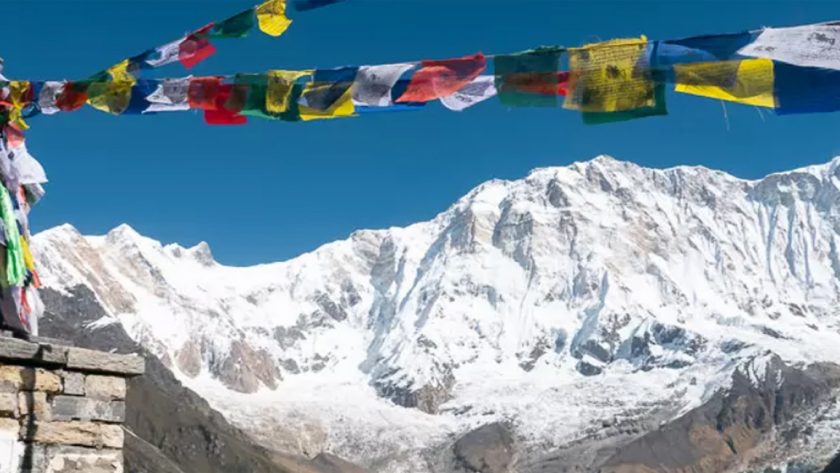Sexuality and Power in the Hindu Society of Nepal
So I was going to Nepal to scale some peaks, work on my calves, experience the giardia weight loss program…Oh yeah, and to reach spiritual enlightenment. What to pack? A backpack, sleeping bag, hiking boots, rain gear, headlamp, wool socks, warm jacket – and a long skirt? Huh? I remember my perplexed reaction to that last item on the list when I read my Moon Travel Handbook.
Days on end of backpacking, challenging myself mentally and physically, ascending up to 1000 meters at a time, carrying more than 30 pounds on my back, sweat pouring, muscles aching, adrenaline pumping, heart racing. All this, they suggested, I experience in a skirt. Baffled, but open-minded, I found my flowery long hippie skirt gathering cobwebs since the last time I saw Jerry at the Vegas Silver Bowl, and abandoned my shorts.
I knew I had been fooled when I entered the tourist-driven part of Kathmandu and saw all the world’s versions of alpine wear. The Boulder-ites were decked out in North Face high alpine gear, the French and Swiss sported Euro versions of the same stuff, the bohemian Germans wore jean cutoffs, the Israelis fresh from required duty sported patchwork bell-bottoms. And me? I was a Deadhead with a long skirt.
The few of us wearing long skirts were definitely drab compared to the others, and we certainly didn’t look like mountaineering pros, but I couldn’t help feeling comfortable. In other countries where I had been warned to “cover up” due to religious and cultural customs, I had been the victim of endless taunts and cat calls even though I was in jeans, careful not to show a bit of leg. In Nepal, in a skirt, I was not harassed. I couldn’t help but notice the sidelong glances women wearing tank tops, shorts, even jeans received from the Nepali men. This is not so surprising, considering this is more flesh than some of these men have seen in their lives. Even the fitted peace-flowered bell bottoms caught men’s attentions and lewd stares.
As tourists we should know all what a revealed leg or hugged hip connotates. I had to consider what I was up against when deciding whether to wear my tank top or sports bra in the streets of the valley or on the trekking routes.
The main reason I didn’t see Nepali women strutting their stuff is because they have been taught that their sexuality is not something to be proud of, but rather, something to hide. The female or, more specifically, women’s sexuality, is deemed a highly powerful, destructive, even dangerous force in Hindu societies. It matters less whether I agreed with Nepali culture, but it’s important that I understood where it’s coming from.
The roots of these beliefs, prevalent in varying degrees in modern Hindu societies, are stories in the Vedas. In his book Hindu Goddesses: Visions of the Divine Feminine in the Hindu Religious Tradition, David Kinsley writes, “No other living religious tradition displays such an ancient, continuous, and diverse history of goddess worship.”
The most powerful and most worshipped of all goddesses is Durga, or Bhagwati, slayer of demons and defender of good. In fact, the biggest festival of the year, and there are a lot of festivals in Nepal, is Dasain, a 10-day festival dedicated to Kali, a manifestation of Durga. It is significant that the biggest festival on the Hindu calendar is all in the name of a female goddess. However worshipped these female goddesses are, the status of “earthly” females is drastically different.
A perfect example is the worship of the goddess Kumari. She is the living virgin incarnation of Durga, who lives in a decorated temple in Kathmandu’s Durbar Square. I’ll never forget visiting her temple, not really believing the stories that this young girl was kept inside, from infancy to puberty, worshipped like a goddess, and escorted in a carriage in processions and festivals. But, sure enough, I saw her, peeping her head out of that wood-carved window, looking very young, beautiful… and bored.
She is chosen at a young age for her “thighs like a deer, chest like a lion, neck like a conch shell, eyelashes like a cow, and body like a banyan.” Her feet cannot touch the ground, so she stays inside and doesn’t attend school. She is said to hold the spirit of Durga, that is, until she sheds “first blood,” or menstruates. At this point, the spirit of the great Durga is said to leave her body, and she is no longer a goddess. A Nepali woman’s sexuality couldn’t be symbolized more negatively than in the example of Kumari, as she moves from being worthy of worship to being unworthy, all due to the onset of her period. To make matters worse, it is believed that any man who marries this ex-goddess will die young.
The female is glorified, even deemed a goddess, in her virgin, non-sexual state. As a menstruating, sexual women, she is feared, quickly controlled, and often banished.
Women suck the blood of men like leeches
The Devi Bhagwat says, “In public women are very modest. But when they find their sex-partners in private they behave as if they want to possess them….Women constantly suck the blood of men like leeches. That very woman whom man considers his beloved robs him of his manhood through sexual indulgence and of his mind, his wealth and all of his possessions. Hence is there a worse robber than woman?”
I had heard the stories of women sleeping outside when they were menstruating, but again, didn’t believe it until I saw it. When I was teaching in a small village in eastern Nepal in a region called Terhathum, I spent the weekend with Regmi, whose family lived 5 miles from the bazaar. Regmi was the region’s veterinarian, esteemed mostly for his bedside manner when dealing with cows, the most sacred animal in Hindu societies. I remember his joking that it was “his week” to cook. My first impression was that here was a very modern husband and wife, taking turns doing the cooking for their family of four. Regmi, a man of the Brahmin, or “priestly”, caste, bathed, changed into clean clothes, read from the Vedas, and made ritualistic markings on his face and forehead before cooking and eating. What I later learned was that the kitchen was the most pure room in the house. It was rare that they would even let a non-Hindu near the room where food was prepared. Allowing a menstruating woman to cook the food, or even be in the kitchen, was completely impure. The same applied to her sleeping in the house during that time of the month.
Although it is now illegal in most Hindu societies, sati was institutionalized through the belief that if a woman were to commit sati, she would be reborn as a goddess. Sati is the custom in which a living widow is cremated on the funeral pyre of her husband. Because of the large number of child-marriages, many women would become widows when they were in their mid-30’s, an age when they were still sexually fertile, and thus dangerous. Sati was a way of controlling or, rather, disposing of these de-virginized, sexual beings who were no longer subject to anyone’s control.
When you really think about it, modesty in dress is a relatively mild prescription.
In Terhathum, I was told not only should I wear a loose skirt, loose shirt, and shawl, but also that I should not make eye contact with or walk in the direction of a man on the street, because it was considered a mild form of seduction. I was even told that since I was an American woman and came from a place where pre-marital sex was the norm, walking in the direction of a man could be considered by some as an “automatic sex invite.”
This was a village high in the mountains far away from the more progressive city of Kathmandu, but you can infer from the explained mythology and institutions what you might be up against even in the tourist sections of town if you don’t watch what you wear. Think of wearing that skirt as refusing to intimidate the men around you. Asserting yourself by busting out in a tank top and shorts might make you feel empowered, and popular at Tom and Jerry’s Pub, but will more likely inspire unwanted taunts from Nepali men and isolate you in general from any genuine connections with Nepali people of any gender.
Do yourself and the tourists who follow you a favor. Wear the skirt. There’s a lot more riding in those hips than you may have thought.
Note: This will also make going to the bathroom a much easier task.




usa phizer brand hame androxal from phizer
cheap androxal buy in australia
cheapest buy enclomiphene australia no prescription
ordering enclomiphene generic mexico
how to order rifaximin price south africa
get rifaximin purchase usa
buying xifaxan cheap trusted
buy cheap xifaxan canada drugs
get staxyn generic for sale
does cheap staxyn work
online order avodart australia suppliers
ordering avodart generic equivalent
how to order dutasteride generic next day delivery
ordering dutasteride real price
flexeril cyclobenzaprine pills from canada
online pharmacy no prescription flexeril cyclobenzaprine
buy gabapentin without a prescription overnight shipping
cheap gabapentin toronto canada
fildena 25 mg price
fildena without doctor rx
buy itraconazole generic good
itraconazole online pharmacy canada cheap
comprar kamagra sin receta medica se puede comprar
kamagra přes noc online
kamagra sans expédition de nuit sans ordonnance
commander 5 comprimés de kamagra